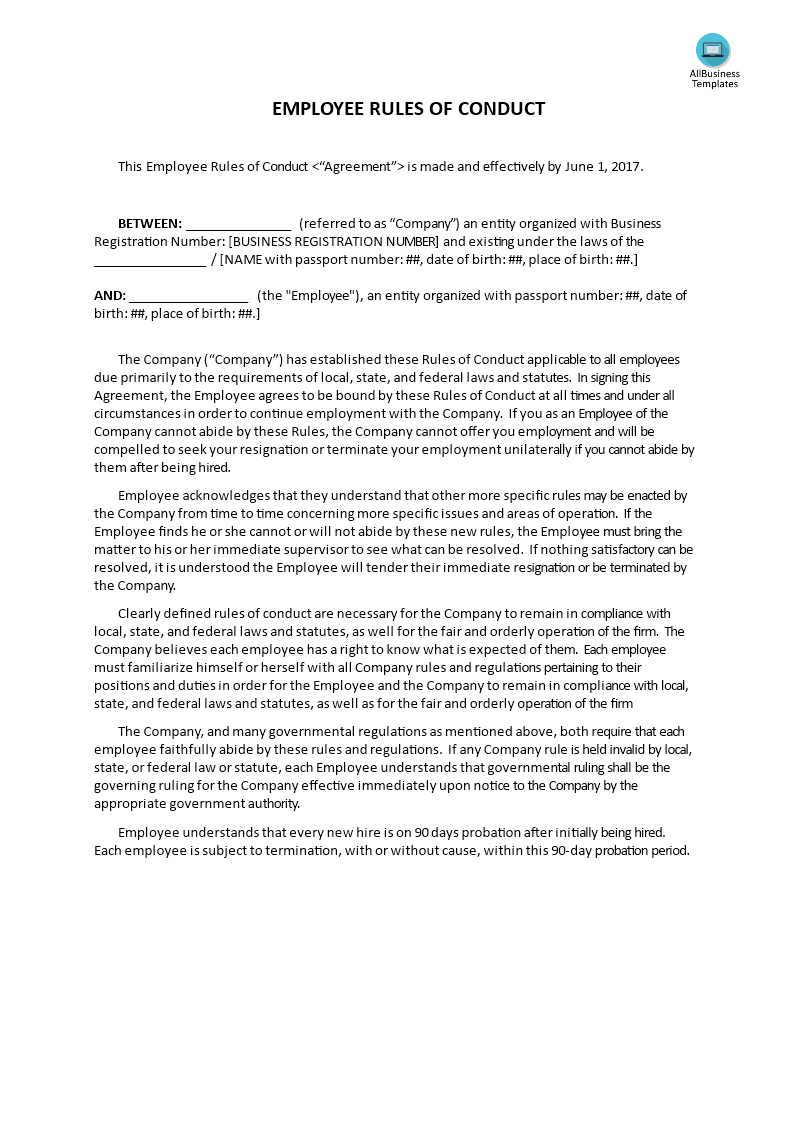Employee Rules Of Conduct
Sponsored Link高级模板 保存,填空,打印,三步搞定!

下载 下载 How should an employee behave in a company? In what ways do workplace rules of conduct apply? this legal Employee Rules Of Conduct template now!
只有今天: USD 1.99
点击购买

可用的免费文件格式:
微软的词 (.docx)- 本文档已通过专业认证
- 100%可定制
- 这是一个数字下载 (34.54 kB)
- 语: English
- 付款完成后,您将收到包含该文件的电子邮件。
Sponsored Link
How should an employee behave in a company? In what ways do workplace rules of conduct apply? You can download our Employee Rules Of Conduct template now. It is a comprehensive document that outlines the expectations of your employees. You can also use this template to create a code of conduct that is tailored to your company's specific needs. Download this legal Employee Rules Of Conduct template now!
Employee Rules of Conduct, often referred to as Employee Code of Conduct or Employee Conduct Guidelines, are a set of written guidelines and expectations established by an organization to govern the behavior and actions of its employees in the workplace. These rules are designed to promote a positive work environment, ensure compliance with company policies and legal regulations, and maintain professionalism and ethical conduct among employees. The specific content and rules within an Employee Rules of Conduct document can vary from one organization to another but typically include the following elements:
- General Behavior: Clear expectations regarding employees' behavior and demeanor in the workplace. This may include requirements for respectful and professional conduct, adherence to company values, and the promotion of a harmonious work environment.
- Attendance and Punctuality: Guidelines for attendance, punctuality, and notification procedures for absences or late arrivals. This section often addresses the importance of regular and reliable attendance.
- Workplace Safety: Rules related to workplace safety, including the proper use of equipment, reporting safety hazards, and following safety protocols. This may also include guidelines on the use of personal protective equipment (PPE).
- Confidentiality: Expectations regarding the handling of confidential and sensitive information. Employees are typically required to maintain the confidentiality of company data, customer information, and proprietary knowledge.
- Use of Company Resources: Guidelines on the appropriate use of company resources, such as computers, email, internet access, and office supplies. This section often addresses the prohibition of personal use of company resources for non-work-related activities.
- Anti-Harassment and Non-Discrimination: Policies that prohibit harassment, discrimination, and retaliation in the workplace based on factors such as race, gender, age, religion, disability, or sexual orientation. Employees are expected to treat colleagues with respect and dignity.
- Ethical Conduct: Standards of ethical behavior, including honesty, integrity, and compliance with applicable laws and regulations. This section may address conflicts of interest, insider trading, and other ethical considerations.
- Dress Code and Appearance: Guidelines for appropriate dress and grooming in the workplace, if applicable. Some organizations may have specific dress code requirements, while others may have more relaxed policies.
- Substance Abuse: Policies related to alcohol and drug use in the workplace, including expectations for employees to perform their duties free from the influence of alcohol or illegal substances.
- Social Media and Communications: Rules regarding the use of social media and other communication platforms in a professional context. This may include guidelines for representing the company online and refraining from sharing confidential information.
- Compliance with Company Policies: An expectation that employees will adhere to all company policies and procedures, which may encompass areas beyond those explicitly listed in the Employee Rules of Conduct.
- Consequences of Violations: Information about the potential consequences of violating the Employee Rules of Conduct, which may include disciplinary actions, up to and including termination of employment.
- Reporting Violations: Procedures for reporting violations of the rules, including whistleblower protections, if applicable.
Employee Rules of Conduct are an essential part of maintaining a productive and respectful work environment. They provide clarity to employees about what is expected of them and help organizations uphold their values, reputation, and legal compliance.
Our trustworthy legal templates are all crafted and screened by professionals. The 3 step process virtually guarantees you can finish and print your legal document in minutes! Feel free to download our basic or advanced template designs, they are intuitive and in several kinds of formats.
Download this professional legal Employee Rules Of Conduct template if you find yourself in this situation and save yourself time, effort and probably reduce some of the lawyer fees! Using our legal templates will help you to reach the next level of success in your education, work, and business! However, we still recommend you to consider consulting a local law firm in case of doubt to support you in this matter.
DISCLAIMER
Nothing on this site shall be considered legal advice and no attorney-client relationship is established.
发表评论。 如果您有任何问题或意见,请随时在下面发布
相关文件
Sponsored Link
